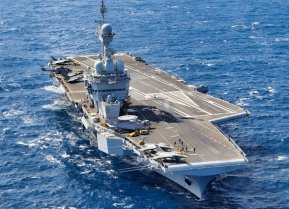U.S. Navy Aircraft Carriers Are Just About Everywhere Right Now
The United States Navy's newest and largest aircraft carrier, the USS Gerald R. Ford (CVN-78) along with her strike group, will remain in the Mediterranean Sea a bit longer.
U.S. Aircraft Carriers Are on the Move – Only the U.S. Navy Can Do This: The United States Navy's newest and largest aircraft carrier, the USS Gerald R. Ford (CVN-78) along with her strike group, will remain in the Mediterranean Sea a bit longer. Last week, Secretary of Defense Lloyd Austin ordered the extension approved a second extension for the carrier – part of the U.S. Navy's military build-up following the October 7 Hamas attacks in southern Israel.
The strike group passed the 200-day mark since the flattop left on deployment in May from Naval Station Norfolk, Virginia, according to USNI News carrier deployment database. The strike group includes CVN-78 and the embarked Carrier Air Wing 8, along with the guided-missile cruiser USS Normandy (CG-60), USS Ramage (DDG-61), USS McFaul (DDG-74) and USS Thomas Hudner (DDG-116).
The USS Gerald R. Ford had been deployed to the region as part of ongoing U.S. and NATO efforts to deter Russia, which launched its unprovoked invasion of Ukraine in February 2022.
U.S. carriers have been spending significant time in the waters of the Mediterranean due to ongoing tensions in the region. The previous U.S. carrier strike group deployment – comprised of the Nimitz-class USS George H.W. Bush (CVN-77) and her strike group – lasted 257 days. U.S. Navy carriers have been continuously deployed to the Mediterranean since December 2021.
Another Nimitz-class carrier, the USS Dwight D. Eisenhower (CVN-69), had been set to relieve USS Gerald R. Ford as part of the Russian deterrence mission but was retasked to U.S. Central Command (CENTCOM) as part of the regional U.S. naval build-up to prevent the conflict in Southern Israel from spreading to other countries, USNI News also reported.
Navy Aircraft Carriers: Packing a Serious Punch
Larger in size than the Nimitz-class carriers, the USS Gerald R. Ford can operate with a smaller crew thanks to a greater emphasis on automation. The warship will also see a reduction in maintenance requirements, as well as a crew workload reduction.
CVN-78 is also capable of carrying upwards of 90 of the United States Navy’s most advanced aircraft, and that will include the F-35C Lightning II Joint Strike Fighter, F/A-18E/F Super Hornet, E-2D Advanced Hawkeye, EA-18G Growler electronic attack aircraft and MH-60R/S helicopter as well as unmanned air and combat vehicles.
In addition, Ford can also be able to recover and launch various Short Take-Off and Vertical Landing (STOVL) aircraft flown by the United States Marine Corps including the F-35B Lightning II.
Another Carrier on a Deterrent Mission
On Monday, the USS Carl Vinson (CVN-70) became the third U.S. Navy flattop to visit South Korea this year, as part of an extended deterrence mission against North Korea's nuclear and missile programs.
The arrival to the southern city of Busan of the third Nimitz-class nuclear-powered aircraft carrier comes as North Korea has announced its intention to launch a rocket carrying a space satellite in the coming days in the direction of the Yellow Sea and East China Sea. It will mark Pyongyang's third attempt to put a spy satellite into orbit.

"An aircraft carrier port visit demonstrates the United States’ commitment to the alliance between the U.S. and the Republic of Korea," said Rear Adm. Carlos Sardiello, commander, CSG-1. "Cooperation between the U.S. and Republic of Korea navies is critical to maintaining peace and security in Northeast Asia and the Korean Peninsula."
The visit to Busan demonstrates U.S. commitment to the region further enhancing relationships with ROK leaders and the local population. Additionally, the visit provides the opportunity for CSG-1 sailors and civilians to rest and recharge while being able to experience the Republic of Korea, the U.S. Navy announced.
Other Navy Carriers on the Move
The arrival of the USS Carl Vinson to South Korea comes just one month after the USS Ronald Reagan (CVN-76) visited the same port just a month ago as part of the aircraft carrier's final full-forward deployment. CVN-76 – which traveled 56,219 nautical miles and conducted daily flight operations with fixed and rotary-wing aircraft amounting to 1,838 launches and recoveries, and 2,157 rotary-wing sorties – also made port visits to Vietnam and the Philippines during the recent deployment.
The carrier, named for the late former President Ronald Reagan, returned to its forward-deployed in Yokosuka, Japan on Sunday.
USS Nimitz (CVN-68), the lead vessel of the U.S. Navy's class of nuclear-powered supercarriers, had berthed in Busan before participating in a substantial joint exercise with the South Korean Navy in March. The flattop returned to its homeport in Bremerton, Wash. July 2, concluding a seven-month deployment to U.S. 3rd and 7th Fleet areas of operations.
The United States Navy operates 11 large nuclear-powered fleet carriers – which can carry upwards of 80 fighters each – the largest warships in the world. The total combined deck space of the Navy's carriers is more than twice that of all the other nations' carriers combined.
Author Experience and Expertise
Peter Suciu is a Michigan-based writer. He has contributed to more than four dozen magazines, newspapers, and websites with over 3,200 published pieces over a twenty-year career in journalism. He regularly writes about military hardware, firearms history, cybersecurity, politics, and international affairs. Peter is also a Contributing Writer for Forbes and Clearance Jobs. You can follow him on Twitter: @PeterSuciu.
All images are Creative Commons.


